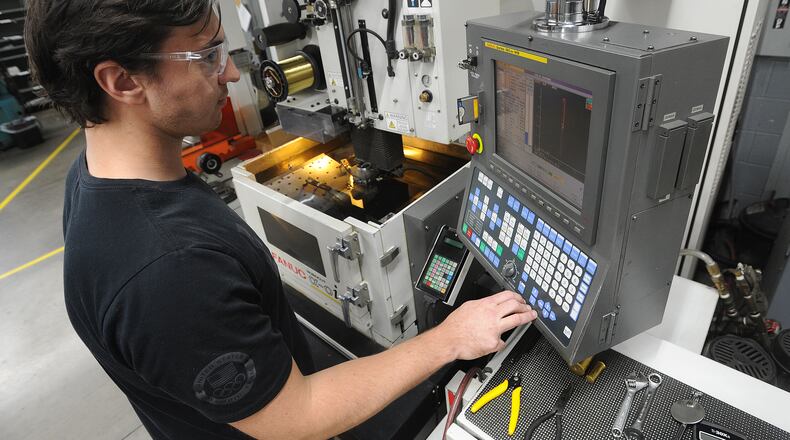Local manufacturers said they want whomever wins the election to focus on coronavirus recovery, as well as workforce development, health care and fixing aging infrastructure.
Trump’s recent campaign event at the Dayton International Airport last month billed as “Fighting for the American Worker” demonstrates how central manufacturing remains to the presidential election. The industry provides about 10% of jobs in the Dayton, Springfield and Cincinnati-Middletown regions.
Analysis of data from the U.S. Bureau of Labor Statistics shows that both Obama and Trump have had net manufacturing job losses under their administrations. However, Richard Stock, director of the University of Dayton Business Research Center, points out that it is more appropriate to compare the two administrations by excluding the recession President Barack Obama inherited and the recent recession caused by the coronavirus during Trump’s term.
Since about 2010, through March of this year, the number of manufacturing jobs has risen steadily in the U.S., Ohio and local cities at nearly the same rate under both administrations.
“From my point of view, their records with respect to manufacturing employment growth would have to be real similar,” Stock said.
What are the candidates plans for manufacturing?
Neither candidate’s plan would have a large impact on the manufacturing industry, Stock believes.
Both candidates plan to spend a massive amount of money on infrastructure next term, which would benefit manufacturing somewhat, Stock said. Aging infrastructure was one of the major concerns mentioned by area manufacturing leaders the Dayton Daily News spoke with.
Biden’s plan for manufacturing calls for a penalty tax on foreign earnings and a tax credit for businesses that bring back manufacturing jobs by revitalizing a closed factory or retooling an existing one, according to Biden’s Ohio campaign office.
Trump’s plan calls for a tax credit for companies that bring back jobs from China and tax deductions for industries like pharmaceuticals and robotics that bring manufacturing jobs back to the U.S. He has also pledged no federal contracts for companies who outsource to China.
Stock assumes Trump would continue to deploy tariffs in a second term, based on Trump’s repeated touting of his tariffs on foreign goods and criticism of Biden as soft on China.
Stock explained that tariffs and other more direct actions proposed by the candidates to penalize manufacturing abroad “wind up being a wash” in regards to creating manufacturing jobs.
“Manufacturing today in the United States is part of a global supply chain where factories in the United States manufacturing are buying parts from all over the globe,” Stock said. “They are themselves often suppliers to some other international manufacturer doing final assembly in some other country. So tariffs wind up being a blunt instrument in the sense that they wind up raising prices for particular manufacturers in the United States, while lowering prices for other manufacturers in the United States.”
Stock believes it comes down to the candidates' overall fiscal policies. While Trump plans to extend his tax cuts for wealthy Americans, Biden plans to reverse those tax cuts.
“So the real question is whether that money is held in the hands of the top 1% will lead to greater manufacturing employment growth than it would if it is taxed away from them and it gets used on a variety of programs that the government would start to institute,” Stock said. “Putting money into the hands of lower middle income or middle income people, which is a lot of what is being proposed under the Biden administration plans, probably winds up helping durable goods industries in the United States.”
What do local manufacturers want?
Area manufacturing leaders told the Dayton Daily News they want to see the next president focus on recovering from the coronavirus pandemic.
Just days after the World Health Organization declared COVID-19 a global pandemic on March 11, Rob Connelly, chairman and chief executive of Eaton-based food preparation equipment producer Henny Penny, watched the numbers. And the numbers weren’t good.
The company achieved only 20 percent of its typical sales in March as restaurants shut down across the country.
But in April, that percentage rose. It rose again in May, then June and slowly in succeeding months, until September, when the company enjoyed its biggest orders month ever.
Henny Penny has been expanding since before the pandemic, adding jobs and manufacturing across 75,000 square feet. The pandemic didn’t derail that. And Henny Penny has not laid anyone off.
“I don’t think there are many in our industry who are actually expanding right now like we are,” Connelly said.
Whoever wins the Nov. 3 election, the CEO doesn’t want to see that derailed. The restaurant and hospitality business has been “devastated” by COVID-19, Connelly said.
“There are an enormous number of closings, millions unemployed," he said. "They need help so they can survive.”
In any downturn, the weakest businesses often perish. This is different, Connelly believes.
“This is a historic stopping of business,” he said.
He professed to be “shocked” that the federal government has not been able to agree on assistance for airlines suffering their worst downturn in decades. American Airlines CEO Doug Parker said last week his airline will proceed with 19,000 layoffs.
“These airlines weren’t bluffing,” Connelly said. “I believe (the government) needs to support the airline business, and the same, to another extent, the hotels.”
Every year the Dayton Region Manufacturers Association surveys its members — some 200 manufacturers and 150 of their suppliers — about their top concerns. The pandemic hasn’t dramatically upended those concerns, said Angelia Erbaugh, association president.
Companies remain concerned about finding the right workers, covering their health care and getting their products to customers in a nation where infrastructure continues to age.
“The top of the list is always the shortage of skilled workers,”' she said. "DRMA members support initiatives that attract, retain, develop and train a workforce.”
In international trade, DRMA members want a “level playing field,” she said, “with as little volatility as possible.”
“I’m not a big one on protracted trade wars,” said Connelly, whose company has manufacturing in Ohio, Washington state and China. “I don’t think that’s good. And I don’t think we need to fight everyone at the same time.”
Jim Bowman, CEO of Dayton’s Noble Tool, feels fortunate that his company is diversified, serving customers in aerospace, medical, physical fitness and other sectors, including defense.
Bowman had to lay off four employees in the past six months, with the aerospace sector down about 40%.
But business in medical, defense and fitness are all up, helping him retain most of his 20 to 50 workers. (He declined to give an exact number for his workforce.)
He’s looking for government that won’t get in the way of that.
“The PPP (Paycheck Protection Program) loan and the Montgomery County CARES Act helped us maintain the greater share of our workforce,” Bowman said.
The federal government provided PPP loans to help small businesses keep their workers employed during the COVID-19 crisis and Montgomery County used some of its allotted funds from the Coronavirus Aid, Relief, and Economic Security Act to provide small businesses with loans.
Bowman wants small businesses to be remembered. He recalled that big automakers had a role in ventilator production early this year.
“That’s great, but here’s this little company with 20 to 50 employees, they want to play, too,” he said. “They want to help. And it’s not just about getting sales.”
Every local race, every local issue
The Dayton Daily News is the only place for complete local election coverage. Go to DaytonDailyNews.com/elections for more stories.
About this story
The Dayton Daily News is examining the presidential candidates' plans to address some of the biggest issues in the region and state. This week we’re investigating their manufacturing policies. Next Sunday we will look at their military policies, followed by their agriculture proposals on Oct. 25.


